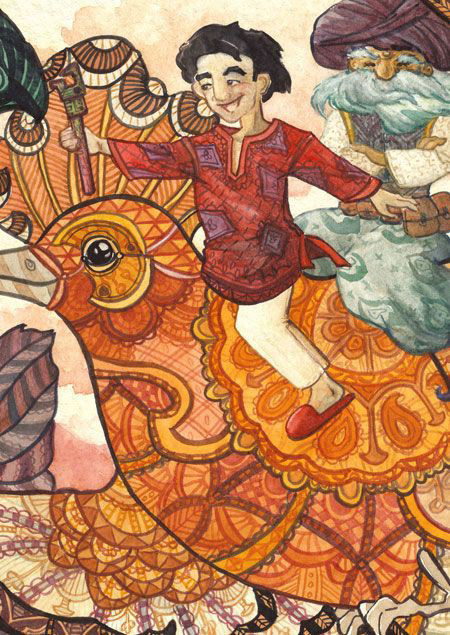Haroun and the Sea of Stories : Novel by Salman Rushdie
Haroun and the Sea of Stories
About the Author Salman Rushdie
Sir Ahmed Salman Rushdie, an acclaimed novelist of Indian origin, is renowned for his unique blend of magic realism and historical fiction. His literary themes often explore the interplay, disruptions, and migrations between Eastern and Western cultures, often set in the backdrop of the Indian subcontinent. Notably, his novel Midnight's Children earned him the prestigious Booker Prize in 1981, recognized as the best among winners on two significant anniversaries of the prize.
However, Rushdie's life took a tumultuous turn after the publication of The Satanic Verses in 1988, which led to multiple assassination attempts and a fatwa issued by Ruhollah Khomeini of Iran. This incident triggered debates on censorship and religiously motivated violence.
Despite the challenges, Rushdie's contributions to literature have been widely acknowledged. He has received accolades such as knighthood for his literary achievements and continues to inspire readers globally through his impactful storytelling.
About the Novel :
"Haroun and the Sea of Stories" is a 1990 children's novel penned by Salman Rushdie, marking his fifth major work following "The Satanic Verses" (1988). This whimsical tale unfolds in a forgotten city, steeped in misery and ruin. Rushdie's narrative serves as an allegory for contemporary societal challenges, particularly within the Indian subcontinent, as seen through the eyes of the young protagonist, Haroun.
The dedication of the book to Rushdie's son, whom he was separated from, adds a personal touch to the story. It delves into themes of censorship, a topic close to Rushdie's heart due to the fatwa issued against him in 1989 by Ayatollah Khomeini. The novel cleverly incorporates puns and allusions in multiple languages, enriching the narrative with linguistic depth.
Through its phantasmagorical elements and nuanced exploration of societal issues, "Haroun and the Sea of Stories" offers readers a captivating journey into the power of storytelling, the struggles of censorship, and the enduring importance of imagination.
Summary: Haroun and the Sea of Stories
"Haroun and the Sea of Stories" is a whimsical tale that follows the adventures of a young boy named Haroun Khalifa. Haroun's father, Rashid, is a renowned storyteller in the land of Alifbay. However, after Rashid's wife Soraya leaves him for Mr. Sengupta, a neighbor, Rashid's storytelling abilities begin to falter.
One day, Haroun discovers that his father's storytelling source, a magical water tap, has been severed by a mysterious shadowy figure. Determined to help his father regain his storytelling prowess, Haroun sets off on a journey to the land of Gup and the Sea of Stories, accompanied by the Water Genie Iff.
In Gup, Haroun learns about the ongoing war between the Guppees and the Chupwalas, led by the evil Khattam-Shud, who seeks to silence all stories. Haroun befriends the Guppee prince, Prince Bolo, and together they hatch a plan to rescue Princess Batcheat, who possesses the unique ability to recall forgotten stories.
Through a series of adventures and challenges, including encounters with fantastical creatures like the Plentimaw Fish and the Shadow Warriors, Haroun discovers the importance of imagination, courage, and the power of stories. He confronts Khattam-Shud and defeats him, restoring the flow of stories to the Sea of Stories and saving his father's storytelling gift.
Ultimately, "Haroun and the Sea of Stories" is a celebration of the magic of storytelling, the resilience of the human spirit, and the triumph of creativity over darkness. Rushdie's tale is a whimsical and allegorical journey that captivates readers of all ages with its enchanting narrative and profound themes.
Analysis of the Novel:
"Haroun and the Sea of Stories" by Salman Rushdie is a captivating novel that explores themes of censorship, storytelling, and the imagination through the eyes of a young protagonist named Haroun. The story unfolds in a fantastical world where Haroun embarks on a magical quest to restore the flow of stories to the Sea of Stories.
One of the novel's main strengths lies in its allegorical representation of societal issues, especially those prevalent in the Indian subcontinent. Through Haroun's journey, Rushdie sheds light on the challenges individuals face in expressing themselves freely in societies marked by censorship and oppression. This aspect is deeply personal, as reflected in Rushdie's dedication of the book to his son, illustrating his own struggles with separation and the quest for creative freedom.
Additionally, the novel emphasizes the significance of storytelling and imagination in shaping cultural identity. Rushdie skillfully blends fantasy and reality, prompting readers to question the boundaries between truth and fiction while highlighting the transformative power of narratives.
The use of language and wordplay further enhances the novel's depth. Rushdie incorporates puns, allusions, and linguistic diversity, mirroring the diverse cultural landscape of the Indian subcontinent and emphasizing the complexities of communication.
Overall, "Haroun and the Sea of Stories" is a captivating and thought-provoking exploration of human experiences, offering valuable insights into the role of literature, the challenges of censorship, and the enduring magic of imagination.
Hope you enjoyed reading the blog.
"A book is a version of the world. If you do not like it, ignore it; or offer your own version in return.”
- Salman Rushdie






Comments
Post a Comment